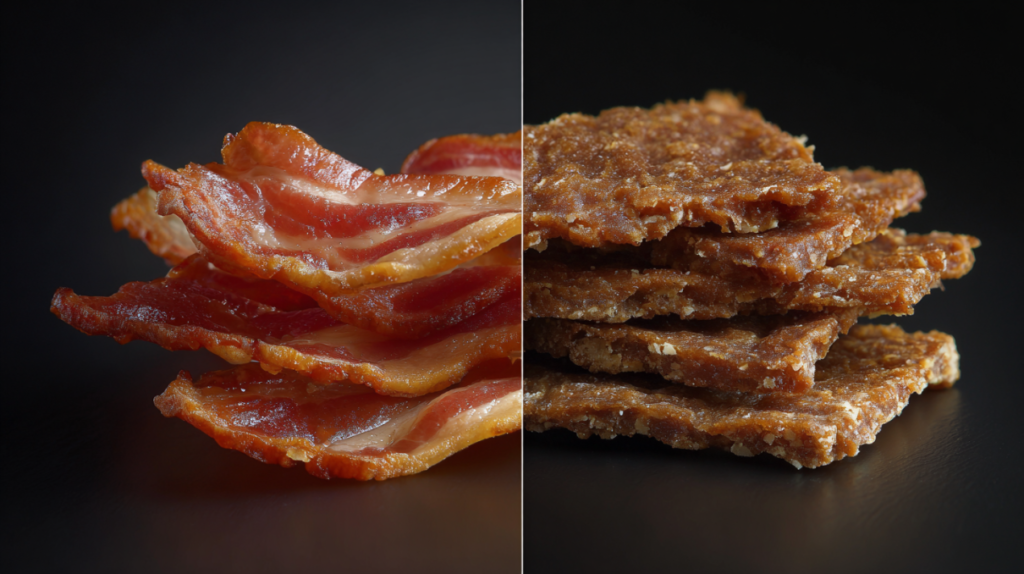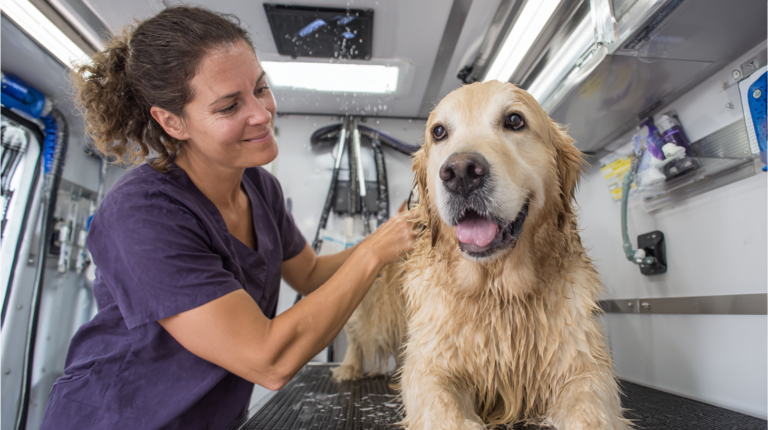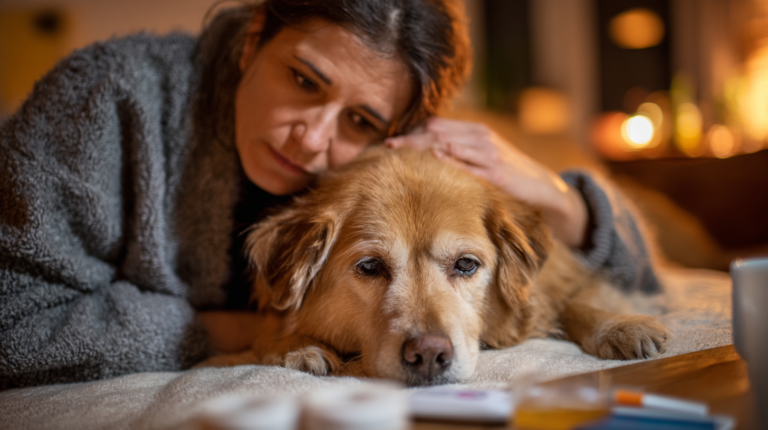Can dogs eat bacon safely? Discover 6 dangerous fat risks, expert veterinary advice, and safe alternatives for your pet’s health and wellbeing.
Table of Contents
Picture this: It’s a lazy Sunday morning, and the irresistible aroma of sizzling bacon fills your kitchen. Your furry companion sits beside you with those pleading eyes, tail wagging hopefully. But before you share that crispy strip, here’s a sobering fact: over 3.2 million dogs visit emergency veterinary clinics annually due to dietary-related issues, with high-fat foods like bacon being a leading culprit.
Can dogs eat bacon? While an occasional tiny piece might not immediately harm a healthy adult dog, bacon poses significant health risks that every responsible pet owner should understand. From dangerous fat content to toxic seasonings, bacon can trigger serious medical emergencies ranging from pancreatitis to sodium poisoning.
This comprehensive guide will explore the six most dangerous fat-related risks of feeding bacon to dogs, provide expert veterinary insights, and offer safe alternatives that will keep your canine companion healthy and happy. Whether you’re a new pet parent or an experienced dog owner, understanding these risks could save your pet’s life.
Understanding Why Bacon Is Problematic for Dogs

Dogs process fats differently than humans, and their digestive systems aren’t equipped to handle the extreme fat content found in bacon. A single strip of bacon contains approximately 3-4 grams of fat, which might seem minimal, but for a 20-pound dog, this represents nearly 10% of their daily recommended fat intake.
Dr. Sarah Mitchell, a veterinary nutritionist at the American Veterinary Medical Association, explains: “Dogs require only 5-8% of their daily calories from fat, while bacon derives 68% of its calories from fat. This dramatic imbalance can overwhelm their digestive system and trigger immediate health complications.”
The problem isn’t just the quantity of fat – it’s the type and processing methods used in bacon production. Commercial bacon undergoes extensive curing processes involving high levels of sodium, nitrates, and various preservatives that are toxic to dogs even in small amounts.
The 6 Dangerous Fat Risks of Bacon for Dogs
1. Acute Pancreatitis: The Silent Killer
Pancreatitis represents the most immediate and life-threatening risk when dogs consume high-fat foods like bacon. This condition occurs when the pancreas becomes inflamed, often triggered by sudden fat intake that overwhelms the organ’s ability to produce digestive enzymes.
Warning Signs of Pancreatitis:
- Severe abdominal pain and hunched posture
- Persistent vomiting and diarrhea
- Loss of appetite and lethargy
- Fever and rapid breathing
- Dehydration and weakness
A study published in the Journal of Veterinary Internal Medicine found that dogs consuming high-fat treats like bacon were 2.3 times more likely to develop pancreatitis within 72 hours. The condition can progress rapidly, requiring immediate veterinary intervention including IV fluids, pain management, and sometimes surgical intervention.
Case Study: Max, a 7-year-old Golden Retriever, consumed three strips of bacon during a family barbecue. Within 8 hours, he developed severe vomiting and abdominal pain. Emergency veterinary care revealed acute pancreatitis, requiring a 4-day hospitalization with intensive treatment costing over $3,200.
2. Gastrointestinal Obstruction and Upset
The high fat content in bacon can cause severe gastrointestinal distress, leading to vomiting, diarrhea, and potentially dangerous blockages. Dogs’ digestive systems struggle to break down the complex fats and proteins in processed meats, often resulting in undigested food particles that can cause obstructions.
Symptoms of GI Distress:
- Projectile vomiting within 2-6 hours
- Bloody or watery diarrhea
- Excessive drooling and panting
- Restlessness and discomfort
- Inability to defecate or strain during bowel movements
The fat in bacon can also slow gastric emptying, causing food to remain in the stomach longer than normal. This delayed digestion increases the risk of bacterial overgrowth and toxic fermentation, potentially leading to gastric dilation-volvulus (bloat) in susceptible breeds.
3. Sodium Poisoning: The Hidden Danger
Bacon contains 137-192 mg of sodium per strip, which is extremely dangerous for dogs. While humans can process high sodium levels relatively efficiently, dogs’ kidneys are much less capable of handling sodium overload, leading to a condition called hypernatremia or salt poisoning.
Stages of Sodium Poisoning:
- Mild: Increased thirst and urination
- Moderate: Vomiting, diarrhea, and loss of appetite
- Severe: Seizures, coma, and potential death
Dogs require only 0.3% of their daily caloric intake from sodium, while a single strip of bacon can provide 15-20% of their daily sodium needs. This massive imbalance can cause cellular dehydration, brain swelling, and cardiovascular stress.
4. Obesity and Long-Term Metabolic Issues
Regular consumption of high-fat foods like bacon contributes significantly to canine obesity, which affects over 56% of dogs in the United States according to the Association for Pet Obesity Prevention. The concentrated calories in bacon (approximately 43 calories per strip) can quickly lead to weight gain, especially in smaller breeds.
Long-term Metabolic Consequences:
- Increased risk of diabetes mellitus
- Joint stress and arthritis development
- Reduced lifespan (up to 2.5 years shorter)
- Decreased quality of life and mobility
- Higher susceptibility to heat stroke
The saturated fats in bacon can also contribute to hyperlipidemia, a condition where blood fat levels become dangerously elevated. This condition increases the risk of cardiovascular disease, liver problems, and insulin resistance.
5. Nitrate and Preservative Toxicity
Commercial bacon contains numerous preservatives and additives that are toxic to dogs, including sodium nitrate, sodium nitrite, and various artificial flavoring compounds. These chemicals, while approved for human consumption, can cause severe reactions in dogs due to their smaller body size and different metabolic pathways.
Toxic Preservatives in Bacon:
- Sodium Nitrate/Nitrite: Can cause methemoglobinemia (blue blood syndrome)
- BHA/BHT: Linked to liver damage and cancer in animals
- Artificial Smoke Flavoring: Contains compounds toxic to dogs
- Garlic and Onion Powder: Causes hemolytic anemia
These preservatives can accumulate in your dog’s system over time, leading to chronic health issues including liver dysfunction, kidney damage, and increased cancer risk.
6. Cardiovascular Stress and Heart Disease
The combination of high fat, sodium, and preservatives in bacon creates a perfect storm for cardiovascular problems in dogs. The excessive sodium content forces the heart to work harder to maintain proper blood pressure, while the saturated fats contribute to arterial plaque formation.
Cardiovascular Warning Signs:
- Difficulty breathing or rapid panting
- Decreased exercise tolerance
- Coughing, especially at night
- Swollen abdomen or limbs
- Bluish gums or tongue
Dogs with pre-existing heart conditions, senior dogs, and overweight pets are particularly vulnerable to bacon-induced cardiovascular stress. Even a single high-fat meal can trigger acute heart episodes in susceptible animals.
Breed-Specific Risks and Vulnerabilities
Not all dogs face equal risks when it comes to bacon consumption. Certain breeds have genetic predispositions that make them more vulnerable to fat-related health issues.
High-Risk Breeds:
- Miniature Schnauzers: Prone to hyperlipidemia and pancreatitis
- Yorkshire Terriers: Small size makes them vulnerable to sodium poisoning
- Cocker Spaniels: Higher rates of pancreatitis and digestive issues
- Dachshunds: Prone to obesity and spinal problems
- Beagles: Tendency toward overeating and weight gain
Moderate-Risk Breeds:
- Labrador Retrievers (food-motivated, prone to obesity)
- Golden Retrievers (cancer predisposition)
- German Shepherds (sensitive digestive systems)
Understanding your dog’s breed-specific vulnerabilities helps you make informed decisions about their diet and treat choices.
Safe Alternatives to Bacon for Dogs
Instead of risking your dog’s health with bacon, consider these veterinary-approved alternatives that provide similar satisfaction without the dangers:
Protein-Rich Alternatives:
- Freeze-dried chicken or beef: High protein, low fat
- Dehydrated sweet potato slices: Natural sweetness, fiber-rich
- Air-dried fish treats: Omega-3 fatty acids, brain health
- Homemade turkey jerky: Lean protein, no preservatives
Preparation Methods:
- Baked Chicken Strips: Slice boneless, skinless chicken breast into strips, bake at 200°F for 3-4 hours
- Dehydrated Liver Treats: Cut liver into small pieces, dehydrate for 6-8 hours
- Frozen Bone Broth Cubes: Homemade bone broth frozen in ice cube trays
These alternatives provide the savory taste dogs crave while maintaining nutritional balance and safety.
Expert Tips for Bacon-Free Dog Training
Many pet owners use bacon as a high-value training treat, but safer alternatives can be equally effective:
High-Value Training Treats:
- Freeze-dried salmon: Irresistible smell, easy to portion
- Dehydrated chicken liver: Concentrated flavor, nutritious
- Small pieces of cooked chicken: Fresh, controllable portions
- Commercial training treats: Specifically formulated for frequent use
Training Treat Guidelines:
- Treats should never exceed 10% of daily caloric intake
- Use tiny pieces (pea-sized) for consistent training
- Rotate treat types to maintain interest
- Always have fresh water available during training sessions
When to Consult Your Veterinarian
Immediate Emergency Situations:
- Vomiting or diarrhea lasting more than 6 hours
- Signs of severe abdominal pain (hunched posture, reluctance to move)
- Difficulty breathing or excessive panting
- Seizures or loss of consciousness
- Inability to urinate or defecate
Schedule an Appointment For:
- Persistent increased thirst and urination
- Changes in appetite lasting more than 24 hours
- Lethargy or behavioral changes
- Any concerns about your dog’s reaction to food
Don’t wait to see if symptoms improve – early intervention can prevent minor issues from becoming life-threatening emergencies.
Common Myths About Dogs and Bacon
Myth 1: “A little bit won’t hurt” Reality: Even small amounts of bacon can trigger pancreatitis in sensitive dogs. The high fat content doesn’t become safer in smaller quantities.
Myth 2: “Wild dogs ate high-fat foods” Reality: Wild canids consumed whole prey with balanced fat-to-protein ratios, not processed meats with artificial preservatives.
Myth 3: “Turkey bacon is safer” Reality: Turkey bacon often contains similar sodium levels and preservatives as pork bacon, making it equally dangerous.
Myth 4: “Cooking bacon differently makes it safe” Reality: The fundamental composition of bacon – high fat, high sodium, and preservatives – remains unchanged regardless of cooking method.
Creating a Bacon-Free Household Strategy
Kitchen Safety Measures:
- Secure Disposal: Use pet-proof trash containers for bacon grease and scraps
- Clean Surfaces: Remove all bacon residue from counters and stovetops
- Educate Family Members: Ensure everyone understands the risks
- Emergency Preparedness: Keep your veterinarian’s contact information readily available
Guest and Family Guidelines:
- Inform visitors about your no-bacon policy for pets
- Provide a list of approved treats for guests to offer
- Supervise interactions between your dog and food during gatherings
- Create designated eating areas away from your pet
The Financial Cost of Bacon-Related Emergencies
Understanding the financial implications of bacon-related health issues can help motivate preventive measures:
Average Emergency Costs:
- Pancreatitis treatment: $2,500-$5,000
- Gastric obstruction surgery: $3,000-$7,000
- Sodium poisoning treatment: $1,500-$3,500
- Long-term obesity management: $1,000-$2,000 annually
Prevention Investment:
- High-quality dog treats: $50-$100 annually
- Regular veterinary check-ups: $200-$400 annually
- Preventive dental care: $300-$600 annually
For more expert pet care tips and product recommendations, visit BlithePet.com — your trusted source for pet wellness.
Educational Table:
Markdown Version:
| Bacon Component | Amount per Strip | Daily Dog Limit (20lb dog) | Risk Level | Health Impact |
|---|---|---|---|---|
| Total Fat | 3-4g | 4-6g | HIGH | Pancreatitis, GI upset |
| Saturated Fat | 1.5-2g | 1-2g | VERY HIGH | Cardiovascular stress |
| Sodium | 137-192mg | 200mg | EXTREME | Sodium poisoning |
| Calories | 43 calories | 400-500 calories | MODERATE | Weight gain |
| Nitrates/Nitrites | 2-5mg | 0mg (toxic) | EXTREME | Blood disorders |
| Preservatives | Multiple | 0 (artificial) | HIGH | Liver damage |
Q: Can dogs eat bacon in small amounts safely?
A: No, even small amounts of bacon can trigger pancreatitis in sensitive dogs. The high fat content (68% of calories from fat) and excessive sodium (137-192mg per strip) make bacon dangerous regardless of portion size.
Q: What should I do if my dog accidentally ate bacon?
A: Monitor your dog closely for 24-48 hours for symptoms like vomiting, diarrhea, excessive thirst, or abdominal pain. Contact your veterinarian immediately if any symptoms appear, as bacon can cause rapid onset of pancreatitis.
Q: Are there any safe bacon alternatives for dogs?
A: Yes! Safe alternatives include freeze-dried chicken, dehydrated sweet potato slices, air-dried fish treats, and homemade turkey jerky. These provide similar satisfaction without the dangerous fat content and toxic preservatives.
Q: Is turkey bacon safer than pork bacon for dogs?
A: No, turkey bacon contains similar sodium levels and preservatives as pork bacon, making it equally dangerous. Both types undergo similar curing processes with nitrates and high sodium content that are toxic to dogs.
Q: How much bacon is toxic to dogs?
A: There’s no safe amount of bacon for dogs. A single strip contains 15-20% of a dog’s daily sodium needs and can provide nearly 10% of their daily fat intake, both of which can trigger serious health complications.
Q: What are the signs of bacon poisoning in dogs?
A: Signs include vomiting, diarrhea, excessive thirst and urination, abdominal pain, lethargy, and difficulty breathing. Severe cases may involve seizures, loss of coordination, or collapse requiring immediate emergency veterinary care.
Q: Can bacon cause long-term health problems in dogs?
A: Yes, regular bacon consumption can lead to obesity, diabetes, cardiovascular disease, liver damage from preservatives, and increased cancer risk. The high sodium content can also cause kidney damage and hypertension over time.
Conclusion
While the question Can dogs eat bacon? might seem straightforward, the answer reveals complex health risks that every pet owner must understand. The six dangerous fat risks – acute pancreatitis, gastrointestinal upset, sodium poisoning, obesity, preservative toxicity, and cardiovascular stress – demonstrate why bacon should never be considered a safe treat for dogs.
The high fat content, excessive sodium levels, and toxic preservatives in bacon create a dangerous combination that can trigger immediate medical emergencies or contribute to long-term health problems. Even small amounts can overwhelm your dog’s digestive system, leading to expensive veterinary bills and potentially life-threatening complications.
Instead of risking your beloved companion’s health, choose from the many safe, nutritious alternatives available. From freeze-dried meats to homemade treats, you can provide your dog with delicious rewards that support their health rather than compromise it.
Remember: your dog’s pleading eyes and wagging tail don’t justify the serious health risks associated with bacon consumption. By making informed choices about your pet’s diet, you’re investing in their long-term health, happiness, and quality of life.
Have a similar experience with your pet? Share it in the comments below! Don’t forget to check out our other helpful guides at BlithePet.com for more expert pet care advice.







